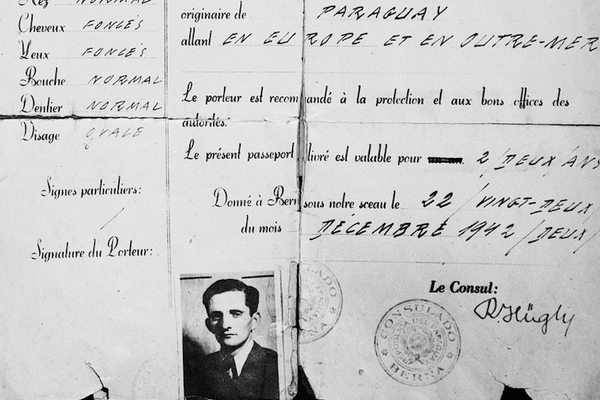A Peek Inside a ‘Scam Manual’ Written to Help Immigrants Avoid Becoming Victims
Early 20th-century migrants from Europe had to be on their guard against marriage brokers, card sharps, ghost mediums, and more.

Many years ago, Loren Pankratz got a call from a rare book dealer. The man was at the end of his career, he told Pankratz, and had a special book to sell. It had been passed down from his grandfather, and perhaps only three other copies existed in the world. He thought Pankratz, a former professor of psychology in Oregon who collects books on cons and frauds, might be interested. Pankratz bought the book, which was in German, and it sat on his shelf for years, unread. Then, years later, he met a translator who helped him understand the gem he was holding onto.
The book was a guide for Germans planning to immigrate to America in the early 20th century. Part guide, part warning, it outlined dozens of scams that a newcomer to the United States might find when they stepped off the boat.
Written by inventor-turned-journalist William Lange and published in 1912, it was called Modern Swindles: A romp through early 20th century con-games, frauds, and fallacies. Pankratz published it for the first time in English in 2022.
The chapter titled “The Con of the Matchmaker” describes how American con artists published their own newspapers, filled with ads for women looking for husbands. Anyone who answered such an ad would have their finances scrutinized and then wrested from them by a so-called marriage broker, with no actual wife at the end of the ordeal. A few pages later, Lange warns readers of the shifty sort who sells a fine watch and then swaps it for an older, less expensive one at the end of a transaction.

German immigration to the United States peaked in the 1880s, and by the 1910s, some 2.3 million German-born immigrants were living in cities across America. Like many new arrivals from abroad in this period, many Germans were coming from farms and industrial areas, directly into big cities such as St. Louis and Cincinnati. Where they came from, most people stayed close to home, where they largely knew the people around them and there were few surprises. Lange, working in cities throughout the Midwest, likely collected his stories of American cons from his fellow newspaper reporters.
“They weren’t ready for the con games that would be available in America,” says Pankratz. “In America you could dress up like anybody. You could be a lowlife, put on fancy clothes, and pretend to be someone else. You couldn’t do that in Germany. Everyone knew who you were and what status you were. The immigrant faced a whole new challenge of identifying and understanding who was in front of you, and that person could be there to take your money.”
Lange’s advice isn’t predicated on religious morals or fear mongering—each chapter is a lesson on being thoughtful. If something sounds too good for it to be true—a good deal on an expensive watch or a wife eager to please—it likely is.


Pankratz began collecting books on cons nearly 50 years ago, and now has more than 800 in his library. But the dealer who sold him this book had been right—he has never come across another guide of this kind, specifically written for immigrants arriving in America. Such books would have been widely useful. At the time, Italian immigrants were particularly targeted by scammers, including one of their own: Charles Ponzi, a schemer who stole millions with his eponymous investment fraud.
In America, an endless stream of books were published on the subject, though not targeted to specific immigrant groups. Written by police detectives, preachers, and reformers, they warned of the sins of New York City in particular: prostitution, elaborate cons, gambling cheats. Some would be applicable across the country, others were oddly specific. One was geared not at city dwellers but rural farmers, warning them of scams such as door-to-door salesmen offering seeds that don’t germinate and chickens that never arrive.
More than a century after Modern Swindles, there is no shortage of books attempting to help us avoid the latest con. In the recent Nobody’s Fool: Why We Get Taken in and What We Can Do About It, two cognitive scientists, Christopher Chabris and Daniel Simons, take a hard look at how our brains are primed to believe. From targeted advertising to misleading scientific studies, we often absorb what’s in front of us without questioning what information is left out. Take, for example, an advertisement for a financial adviser who brags about picking Amazon and Tesla before they were well known. Few would think to probe deeper: What bad stocks did he invest in? And what good stocks did he miss?

Our weakness is our otherwise-helpful ability to focus intently on what’s presented to us, argue Simons and Chabris in the opening chapter. “This downside of focus creates one of the oldest and easiest ways for frauds, hucksters, and marketers to fool us into making bad choices,” they write. “They don’t have to hide critical information from us—they only need to omit it, and count on us not to think about it ourselves.”
As a society, we hold a certain admiration for the inventiveness of such schemes and schemers—think about the exploits of con artists that have made their way to film, from The Music Man and The Hustler to Catch Me If You Can and Inventing Anna. And, like the scams themselves, that’s nothing new. In the 1896 Frauds of America: How they are worked and how to foil them, author E.G. Redmond writes, “The country is filled with adventurers, rascals great and small, with men so industrious in uncanny lines as to cause one to admire the persistent pluck with which they energetically go ahead to their own ruin, employing faculties for their own destruction which rightfully utilized might make them not only solid and respectable citizens, but brilliant and impressive.”
Today, our scams span far wider than authors could have imagined at the turn of the 20th century—thank the internet for that. But Modern Swindles still lives up to its name. Even if the precise cons are longer applicable, their trademarks are the same—an offer too good to be true, a bait-and-switch, a cut-rate deal. The warnings are as relevant to a modern suburban family in Phoenix as they were to an early 20th-century immigrant from Schleswig-Holstein.

In Lange’s chapter on matchmaker cons, Pankratz makes this point via a footnote in the translation. In 2019, there were 25,000 reports of romantic cons filed with the Federal Trade Commission, for a total loss of $200 million. By 2022, that realm had skyrocketed to 70,000 people scammed out of $1.3 billion.
The human brain is more apt to believe than to doubt, says Pankratz, who has spent decades studying the psychology of deception. “The mind automatically goes into belief mode and you have to pause to monitor what’s going on and see that there are things that don’t quite make sense,” he adds. “You have to ask, ‘Why is it this way?’”
Nina Strochlic covers stories about migration, conflict, and interesting people across the globe. She was previously a staff writer for National Geographic, Newsweek, and the Daily Beast. She cofounded the Milaya Project, a nonprofit working with South Sudanese refugees in Uganda.



































Follow us on Twitter to get the latest on the world's hidden wonders.
Like us on Facebook to get the latest on the world's hidden wonders.
Follow us on Twitter Like us on Facebook